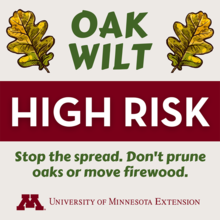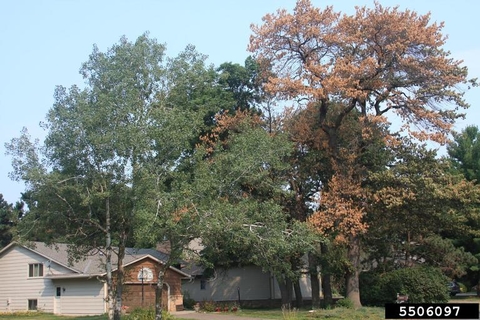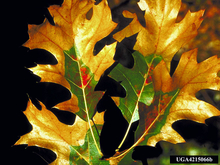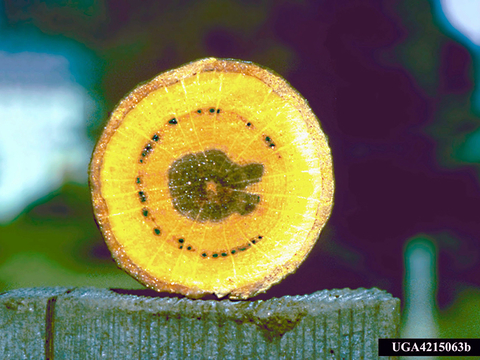Quick facts
- Oak wilt is a fatal tree disease caused by a fungus that affects all species of oak trees.
- Oak wilt spreads from diseased to healthy trees either below ground via connected roots or above ground by insects.
- DO NOT prune oaks from April through July to prevent infection by sap beetles. Immediately cover unavoidable wounds with a latex-based paint or shellac.
- DO NOT move logs or firewood from recently wilted oaks, and don’t move fresh oak firewood from oak wilt-infected areas.
Current oak wilt risk: HIGH
Don't wound, prune or fell oaks in counties affected by oak wilt during this period. Immediately cover unavoidable wounds with paint or shellac.
In general, the risk level in Minnesota is high from April through July. Risk levels can vary considerably based on seasonal change and location. Always check the oak wilt risk status for your date and location before pruning or wounding oaks.
Oak wilt is caused by the fungus Bretziella fagacearum and is responsible for killing large numbers of oaks every year in Minnesota.
Oak wilt is most severe in the red oak species group such as northern red oak and northern pin oak, and black oak. It also affects white oak species such as white oak, swamp white oak and bur oak, but it kills them more slowly.
Fortunately, several management techniques exist to prevent or control oak wilt.
Oak wilt identification
Leaf discoloration and wilt, tree mortality, and fungal spore mats can indicate the presence of infection. However, several other tree diseases can exhibit similar symptoms. Get an accurate diagnosis of the disease before taking any control action. Hire an experienced tree care professional or consult the University of Minnesota's Plant Disease Clinic.
Oak wilt symptoms in red oak species
Tree mortality
- Oak wilt progresses quickly in red oak species and trees do not survive.
- If infected in the branch, complete wilting, leaf loss, and tree death can occur in as little as four weeks.
- If infected by root grafting, complete wilting and tree death can occur shortly after leaf-out the following spring.
- Diseased red oaks can often be easily spotted in the summer because of their bright red-brown leaves.
Leaf symptoms
- Look for leaves with brown edges and green centers. Leaves will continue browning toward the center and base of the leaf.
- Wilted leaves drop off quickly and can be found on the ground around the dying tree.
- Wilting usually starts at the top or outer portions of the tree crown and quickly progresses downward.
Bark and branch symptoms
- When the bark is peeled back from a branch with wilted leaves you may see bluish staining on the wood surface.
- Cracking bark or fungal mats may be present on the tree trunk.
Oak wilt symptoms in white oak species
- White oak
- Bur oak
- Swamp white oak
- Chinkapin oak
Tree mortality
- The disease progresses very slowly in white oak species in Minnesota.
- The disease may develop from year to year with tree death occurring between 2 and 5 years or longer after the first symptoms develop.
Leaf symptoms
- Look for leaves with brown edges and green centers. Discoloration generally occurs from the tip and edges toward the middle or base of the leaf, but symptoms may be irregular.
- Wilted leaves drop off quickly and can be found on the ground around the dying tree.
- Symptoms often initially appear in one to several scattered wilting branches but may progress slowly and develop no further symptoms until the next year or following years.
Bark and branch symptoms
- A dark brown to black discoloration on the wood surface may be found when the bark is peeled back from a branch with wilting leaves.
- Walled-off fungal infections (seen as rings or narrow discolored wood) may be observed in the cross-section of an infected branch.
Oak wilt spread
Insect transmission is how new oak wilt centers start, but most new infections are caused by the oak wilt fungus spreading through the roots of nearby trees that have grafted together.
Where is oak wilt found in Minnesota?
In Minnesota, the disease currently extends through central Minnesota and encroaches on the northern forest. The greatest concentrations of oak wilt are found in Sherburne, Anoka, Isanti and northwestern Dakota counties.
Check the DNR website for a map of the current known range of oak wilt disease. The known range in Minnesota where oak wilt is threatening is shown in shaded areas.
Spread by insects
- Two species of sap beetles, Colopterus truncatus and Carpophilus sayi, are the primary insect transmitters of the oak wilt fungus from diseased trees to healthy trees in Minnesota.
- Sap beetles are attracted to the chemicals produced by the oak wilt fungal mats between the bark and the wood (cambium) of oak wilt-infected trees.
- Sap beetles are strongly attracted to tree chemicals associated with fresh, wood-penetrating wounds. So, wounded oak trees visited by fungus-contaminated beetles can result in oak wilt spread, particularly during the spring months.
- Although oak wilt mats are commonly produced in spring and fall, the mats produced April through July on red oaks that wilted the previous year are most important in disease spread. During this same period, oaks produce large diameter “spring wood” vessels as part of growing wood that are particularly susceptible to infection by the oak wilt fungus.
- Oak bark beetles (Pseudopityophthorus species) are important oak wilt carriers in some parts of the U.S., but not in Minnesota.
Spread through roots
- Root grafting depends on the oak species involved, the size of the trees, soil type and terrain. For example, root grafting is common among northern pin oaks on sandy soils in flat terrain.
- The maximum distance over which root grafting may occur depends on the same factors.
- The more distance between diseased trees, the less likely the disease will spread by root grafting.
- The majority of such spread in a Minneapolis-St. Paul urban study was found to occur within 30 feet. Researchers found that wilt did occur in some trees up to 50 feet from the nearest infected tree.
- Root grafts may occur between different oak species, such as between northern pin oaks and bur oaks.
Oak wilt prevention and management
The coordinated use of several actions is the best strategy to stop the spread of the oak wilt fungus. An integrated management approach for a property with oak wilt could involve:
- Root cutting.
- Treating uninfected, high-value trees with fungicides.
- Removing wilted red oaks that continue to produce the oak wilt disease.
- Properly disposing of logs from wilted trees.
- Planting a diverse mix of tree species on your landscape.
- Avoid wounding or cutting healthy oaks, particularly during spring and early summer, to prevent fungus spread by the sap beetles.
- If you must prune branches or cut down trees, immediately treat the cut surface with water-based paint, a pruning or wound sealer, or shellac.
In general, the risk level for Minnesota is SAFE from November through March, HIGH from April through July, and LOW from August through October. But in spring the risk level can vary considerably based on seasonal change and location.
University of Wisconsin Extension provides a web tool to assess the risk of oak wilt based on the predicted presence of sap beetles in spring. Check the model for your date and location before pruning or wounding oaks.
Seasonal risk of oak wilt fungus spread by sap beetles
| Time of year* | Risk of insect spread | Advisory notes |
|---|---|---|
| April through July | High risk | Do not wound, prune or fell oaks in oak wilt-prone counties during this time period. If trees are wounded or must be pruned for safety reasons, immediately cover wounds with a latex-based paint or shellac. |
| August through October | Caution: low to very low risk | Depending on weather conditions and insect populations, infections could occur but would be rare. As a precaution, immediately treat pruning wounds, stump surfaces of felled trees and other wounds with paint or shellac. |
| November through February | Safe | Now is the time to prune! Fungal pathogens and insect vectors are inactive. |
| March through mid-April | Caution: low to some risk | Depending on spring temperatures, your location, and other factors, new overland transmission is possible during this period. As a precaution, immediately treat pruning wounds, stump surfaces of felled trees and other wounds with paint or shellac. |
* Exact dates for the beginning and end of each time period may vary from year to year.
Root grafts most commonly occur between closely related oak species (red oaks). Healthy trees of a different species can be found in oak wilt infection centers (bur oaks in a red oak infection center). Cutting root connections between diseased and healthy oaks is the best way to prevent the expansion of existing oak wilt centers, where oak trees initially died from oak wilt.
Hire an experienced tree care professional to mark lines and complete the root-cutting procedures. Use the following techniques and procedures:
- A vibratory plow with a 5-foot-long blade is commonly used to cut the roots.
- Your tree care professional can use other equipment such as a trenching machine, backhoe and mini-excavators, but they are more disruptive to the site, require back-filling with soil, and often do not reach a 5-foot depth.
- Careful digging with shovels may be necessary in situations where oaks are near houses, retaining walls or other structures.
- The primary control line is generally placed between the first and second ring (or tier) of healthy oaks out from the diseased trees. This is because the healthy-appearing trees closest to the diseased trees may already have the fungus in their roots, even if they appear non-symptomatic.
- When only using a primary control line, the healthy oaks within that line can be removed after root cutting is finished. Or, they may be monitored for several years and removed if they wilt.
- A secondary control line may be placed between the diseased and healthy trees to preserve additional trees. This secondary control line often fails though and complicates management efforts.
Timely removal and proper treatment or disposal of diseased oaks are critical for preventing insect spread. This is most important for red oak species killed by oak wilt because fungus mats are commonly produced on them. Check with a tree waste disposal site or your local county, city or municipality for how to properly dispose of diseased wood.
Trees that wilted during the growing season should be felled in the fall (after root cutting) or winter (if no root cutting takes place) and either treated on the property or promptly transported to an approved wood waste disposal site.
Options for treatment on the property include debarking the trunk, or cutting logs into firewood lengths and stacking to allow for drying.
Avoid moving logs or firewood from infected oaks during the high-risk period. If diseased trees or firewood are not removed before the high-risk period begins in spring, the cut and stacked logs should be covered with 4-6 mil clear plastic tarp by late March of the year following tree wilt to prevent beetles from reaching the spore mats. Completely bury the edges of the tarp to prevent sap beetles from coming into contact with spores. The tarp should be thick enough to prevent punctures.
When not in the high-risk period, you can split oak into firewood segments no wider than 4 inches and pile loosely before January to allow logs to dry out before spring. You can also burn, debark and chip infected logs and branches, or kiln-dry or process logs into lumber before April. Chips and bark will not spread infection, so they can be left on site.
For areas where oak wilt is common, leave infected trees standing for one year after death.
DO NOT move logs or firewood from recently wilted oaks or areas with infected oaks. Oak wilt mats may form on these logs.
Long-distance movement of firewood may result in the establishment of oak wilt in distant areas that previously had been unaffected by the disease.
Systemic injection with propiconazole by qualified arborists prevents oak wilt symptoms for up to two years in healthy oaks if the oaks are not already infected with oak wilt.
- Propiconazole will not prevent the movement of oak wilt through oak roots and is not a substitute for severing root grafts, so root cutting is still necessary to stop the outward progression of the disease.
- Propiconazole treatment of white oaks (both Q. alba and Q. macrocarpa) already exhibiting early symptoms of oak wilt (less than 30% of crown affected) can prevent further disease development for at least two years.
- Treatment of red oaks already showing symptoms is not recommended; therapeutic treatments frequently fail.
CAUTION: Mention of a pesticide or use of a pesticide label is for educational purposes only. Always follow the pesticide label directions attached to the pesticide container you are using. Be sure that the area you wish to treat is listed on the label of the pesticide you intend to use. Remember, the label is the law.
Reviewed in 2024





